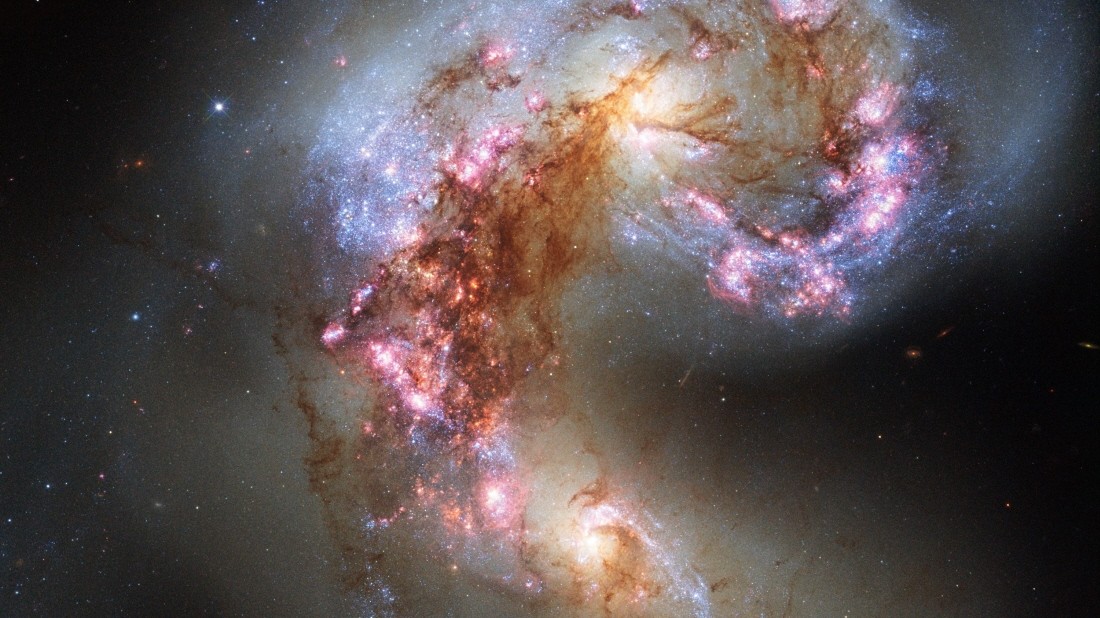When in September 2015 the Ligo Large Laser Interferometer at two sites in the USA caught gravitational waves from space for the first time, the news spread around the world. The new measurement method opened another window for astronomers, through which they have been intensely searching the universe ever since. Now, for the first time, an international team has observed gravitational waves without such detectors — with the help of pulsars, the remnants of heavy stars.
Measurements of gravitational waves with conventional detectors are now routine, but the waves detected now would not have been observable with them. Because the causative event is different: they supposedly originated in galaxy collisions and come from orbiting black holes, not from their mergers.
Galaxies like the Milky Way with billions of stars are the largest objects in the universe. When and how they came about is still a mystery. However, the researchers agree that each galaxy has its own evolutionary history in which cosmic collisions play an important role. For although the universe consists largely of empty space, there must have been frequent collisions between galaxies, especially in the universe’s turbulent youth. But accidents still happen today and in the future in between. For example, in a few billion years, our galaxy, the Milky Way, and its neighbor, the Andromeda Nebula, will merge into one giant galaxy, which astronomers call Melcomeda.
The world’s islands dance around one another – and with them the black holes at their centres
Theoretical models and practical observations show that such a collapse does not occur directly. Instead, the world’s islands dance around one another before unity – and with them the black holes stuck in their centers. The wild dance of these collective monsters not only injects vast quantities of gas into the core of the newly emerging galaxy, but also causes space-time to shiver. As a result, gravitational waves race through space at the speed of light.
“This evolution of Milky Way systems, where smaller systems become larger, occurs at all times and everywhere in the universe,” says Michael Kramer, director of the Max Planck Institute for Radio Astronomy in Bonn. “So we hypothesize that gravitational waves from galaxy collisions add some kind of background noise.” And it is precisely this noise in space-time that Kramer and his colleagues are now observing in several countriesas in the magazine Astronomy and astrophysics to report. However, the research groups did not use the usual laser interferometers, but natural detectors in space: pulsars, which are the bodies of heavy stars.
When the massive sun falls into an energy crisis at the end of its life, heavier and heavier elements, including iron, are produced in quick succession in its core. Then, it’s over, the dying star loses its balance and collapses under its own weight. The energy released in this process explodes from the outer shells and a supernova lights up. A mere 25-kilometer-sized ball remains a remnant of the furious finale. The substance in it is so densely packed that a thimble has a mass of a billion tons.
Such a neutron star rotates rapidly around its axis. A strongly magnetized star emits electromagnetic radiation in two cones collected along the direction of the magnetic field. Since this is at an angle with the axis of rotation, the cones rotate with the star. If they pass over the Earth, the neutron star will flicker in the rhythm of its rotation like a distant beacon and appear as a pulsar in the terrestrial sky.
“This effect serves as the basis for our measurements, because pulsars are among the most accurate clocks imaginable,” says Kramer. Its radio signals travel several light years through space before they reach ground-based telescopes and can be measured there. “Actually, pulsars should move very regularly. But they don’t,” says astronomer Boone. And this is precisely because space is not devoid of overlap. Many light-years of gravitational waves flow through the universe, created by galaxies merging. They compress and stretch the structure of space-time, that is, change the path length and, accordingly, the arrival time of the pulses. These get to Earth either too late or too early.
The effect is small, the inaccuracy of gravitational-wave pulsating clocks of about 30 billionths of a second. “This corresponds to a small change in the signal’s travel distance,” says Kramer. The distance to the nearest fixed star of about 40 trillion km will vary by about 120 metres.
Kramer participates in EC measurements. This European pulsar timing array works with 25 pulsars dotted in the Milky Way, which have been measured over decades with five radio telescopes – including the 100-meter antenna at Eifelsberg near Bonn – and spanning a galaxy-sized detector. Using the same principle, North American, Australian, Indian, Japanese and Chinese teams have also spotted pulsars and are now publishing their work as well. They all come to the same conclusion: the most plausible origin for the observed background noise from gravitational waves is binaries of black holes millions to billions of times the mass of the Sun, formed during galaxy mergers. Conventional laser interferometers such as Ligo do not see the emitted gravitational waves because their frequencies are too low.
On the contrary, the sensitivity of the timing pulsar array is not currently sufficient to resolve the background noise in individual sources, as is possible with conventional detectors. “It’s like hearing chatter at a cocktail party through a closed door,” says Michael Kramer. “Our goal is to one day be able to understand individual snippets of conversation.” Then the message of gravitational waves from the evolution of the galaxy can be heard more closely.

“Total coffee aficionado. Travel buff. Music ninja. Bacon nerd. Beeraholic.”








More Stories
Coral Seeding: Artificial Insemination Makes Coral More Heat Tolerant
Fear, Anger, and Denial: How People Respond to Climate Change – Research
LKH Graz: Using radiation to combat heart arrhythmias